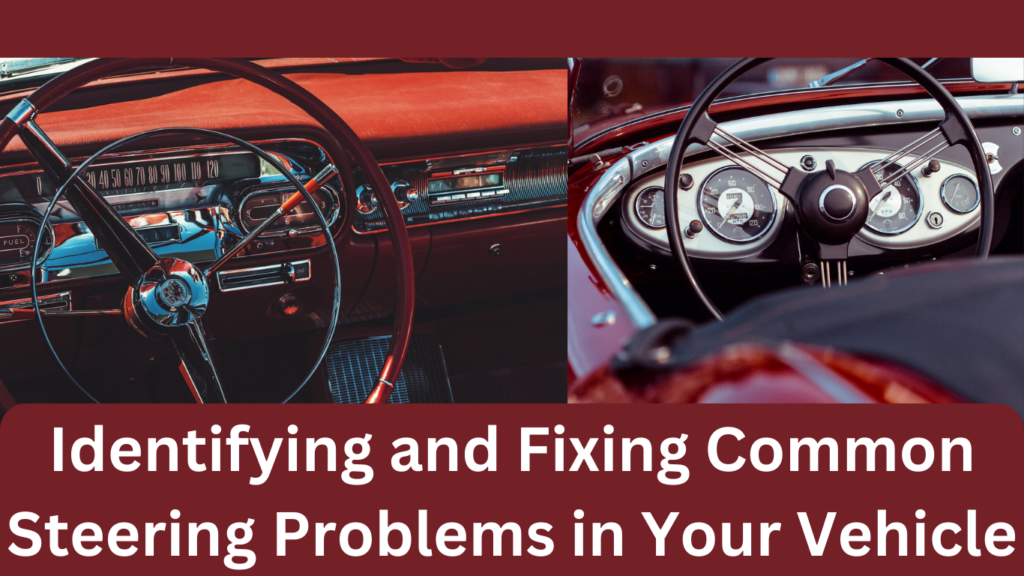Your car’s steering system is not just about pointing your vehicle in the right direction; it’s a crucial aspect of safety, control, and overall driving experience. When your car’s steering starts to act up, it’s essential to address the issue promptly. In this guide, we’ll walk you through the process of identifying and fixing common steering problems that middle-class car enthusiasts often encounter. Whether you’re an experienced DIY mechanic or simply want to understand more about your vehicle, this article is for you.
1) Understanding the Steering System
Before we dive into specific steering problems, it’s essential to have a basic understanding of how your car’s steering system works. Most modern vehicles use a rack-and-pinion steering system, which converts the rotation of the steering wheel into lateral movement at the wheels. This system is comprised of several key components, including the steering wheel, steering column, rack and pinion, tie rods, and various other linkages.
2) Common Steering Problems and Their Causes
2.1) Steering Wheel Vibration
Causes: Steering wheel vibration can be caused by unbalanced tires, misaligned wheels, or worn-out suspension components. It can also be a sign of problems with your car’s steering linkage or steering gearbox.
Fix: Start by checking your tire balance and alignment. If the problem persists, have your suspension and steering components inspected by a professional mechanic.
2.2) Hard or Stiff Steering
Causes: Hard or stiff steering could result from low power steering fluid, a faulty power steering pump, or issues with the steering gear.
Fix: Begin by checking your power steering fluid level. If it’s low, top it up to the recommended level. If the problem persists, consult a mechanic to diagnose and fix the issue.
2.3) Steering Wheel Play
Causes: Excessive play in the steering wheel can be caused by worn-out tie rods, ball joints, or a loose steering gearbox.
Fix: Inspect the tie rods and ball joints for wear and replace them if necessary. Tighten any loose steering components. If the issue persists, consult a professional mechanic.
2.4) Noisy Steering
Causes: Unusual noises when steering can be attributed to low power steering fluid, a worn-out power steering pump, or air bubbles in the power steering system.
Fix: Check the power steering fluid level and top it up if necessary. If the noise continues, have the power steering system inspected by a mechanic.
2.5) Pulling to One Side
Causes: If your car consistently pulls to one side when driving, it could be due to misaligned wheels, uneven tire pressure, or worn-out suspension components.
Fix: Check your tire pressure and ensure it’s even on both sides. If the problem persists, get a professional alignment and suspension check.
3) DIY Fixes for Steering Problems
While some steering problems require professional attention, there are several DIY fixes you can attempt if you’re comfortable working on your vehicle:
3.1) Tire Rotation and Balance
Regularly rotating and balancing your tires can prevent steering-related issues caused by uneven tire wear. You can do this yourself with a jack, jack stands, and a tire iron, or visit a local tire shop for the service.
3.2) Power Steering Fluid Check
Checking and topping up your power steering fluid is a simple DIY task. Refer to your vehicle’s manual for the location of the power steering fluid reservoir and the correct type of fluid to use.
3.3) Tie Rod and Ball Joint Inspection
You can visually inspect tie rods and ball joints for signs of wear or damage. If you notice any play or wear, consider replacing them. Keep in mind that this may require some mechanical expertise.
4) When to Seek Professional Help
While DIY fixes can address some steering issues, it’s crucial to recognize when a problem is beyond your expertise. Here are signs that you should consult a professional mechanic:
- Unidentified or complex noises: If you can’t pinpoint the source of unusual steering noises or the problem persists after simple fixes.
- Loss of steering control: If your steering becomes unpredictable or difficult to control, it’s a safety concern that requires immediate professional attention.
- Steering fluid leaks: If you notice power steering fluid leaking from your vehicle, it’s best to leave the repair to a professional as it often involves specialized equipment.
5) Steering Maintenance Tips
Preventing steering problems is often easier and more cost-effective than fixing them. Here are some maintenance tips to keep your steering system in top shape:
- Regular Servicing: Stick to your vehicle’s recommended maintenance schedule. Regular inspections can catch potential issues before they become major problems.
- Alignment and Balancing: Periodically check and adjust your wheel alignment and tire balance to ensure even tire wear and optimal steering performance.
- Fluid Checks: Keep an eye on your power steering fluid level and change it according to your vehicle’s maintenance schedule.
- Suspension Inspection: Include a suspension inspection as part of your routine maintenance. This can help catch worn-out components before they affect your steering.
Conclusion
Your car’s steering system is not something to be taken lightly. Maintaining it in good condition ensures not only a smooth and comfortable drive but also your safety on the road. By understanding common steering problems, knowing when to DIY and when to seek professional help, and following regular maintenance practices, you can keep your vehicle’s steering system in top-notch shape. Remember, a well-maintained steering system leads to a safer and more enjoyable driving experience for you and your passengers.



